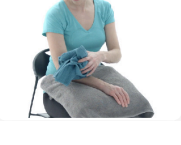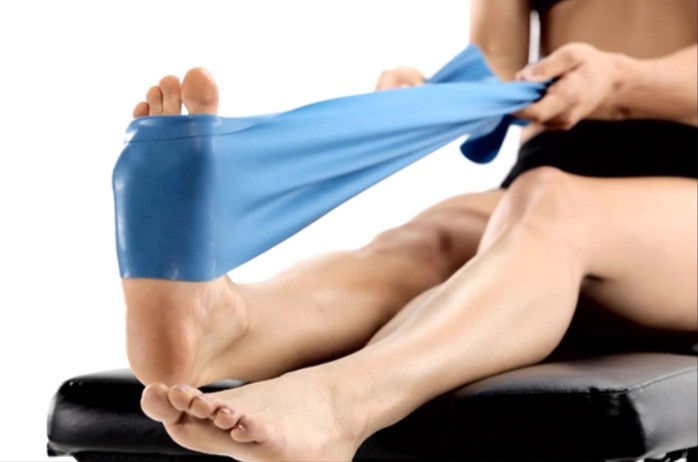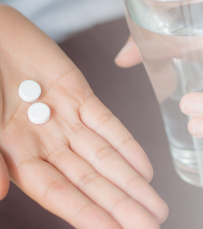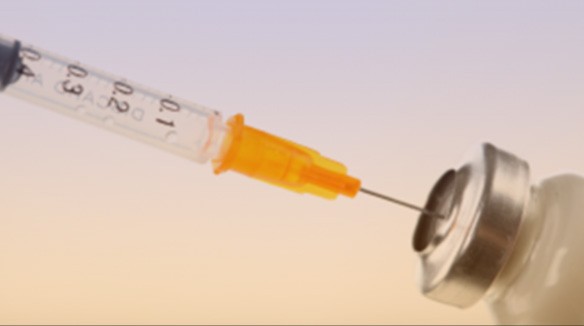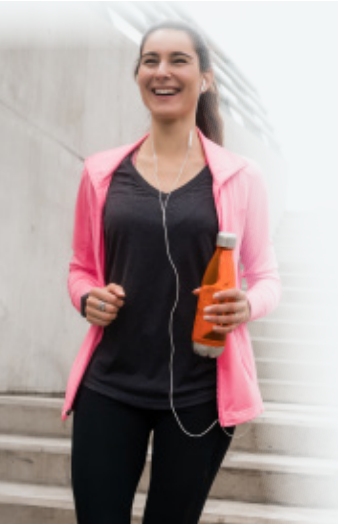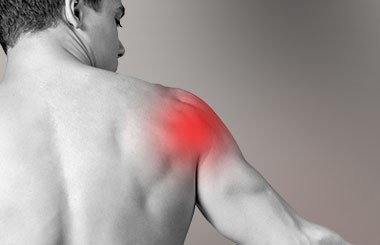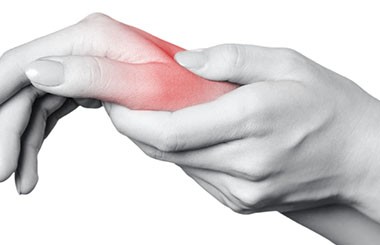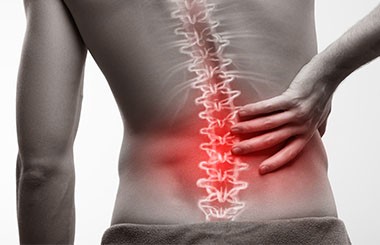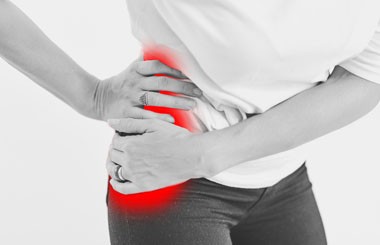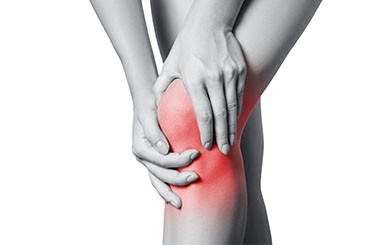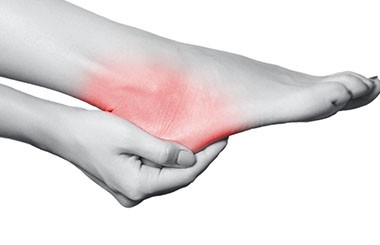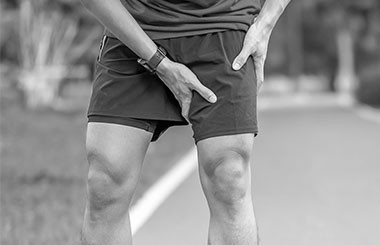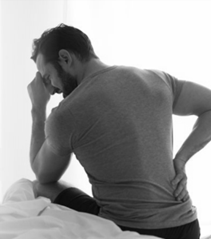Below you will find some general advice about keeping active, the use of heat and cold treatments, safety information when using resistance exercise bands and information on pain medication and steroid injections. Please read the information below and talk to your health care professional if you have any questions or concerns.
Safe use of heat treatment
If you suffer from the following conditions, please discuss the use of heat treatment with a Healthcare Professional before using:
- Heart condition e.g. Angina
- Peripheral vascular disease
- High temperature / acute infection
- Loss of sensation to hot / cold e.g. over areas of scar tissue or numb areas or nerve damage
- Skin conditions such as: Dermatitis, eczema, broken skin.
- Previous reaction to using heat
- Poor circulation
- History of cancer or tumour
The use of heat is normally used to increase blood flow / circulation, reduce pain, ease stiffness, warm up muscles before exercise, relax muscles when tense and decrease muscle spasm.
Methods for applying heat:
- Hot packs / wheat bags
- Hot water bottle
- Hot bath/shower
- Whirlpool
- Follow manufacturer guidelines for heating wheat bags / heat packs safely
- Make sure the hot water bottle / wheat pack is wrapped in towelling and has sufficient layers to avoid burns (never use boiling water)
- Check the skin regularly for signs of skin irritation / burns
- Do not go to sleep whilst using heat treatment.
- Leave on for 10 - 15 minutes and then remove.
- Heat treatment may be repeated up to three times a day
- If using hot water in a bowl (for your hand or foot) – the temperature should be between 40 - 45° C
Safe use of cold treatment
If you suffer from the following conditions, please discuss the use of cold treatment with a Healthcare Professional before using:
- Heart condition e.g. Angina
- Peripheral vascular disease
- High temperature / acute infection
- Loss of sensation to hot / cold e.g. over areas of scar tissue or numb areas or nerve damage
- Skin conditions such as: Dermatitis, eczema, broken skin.
- Previous reaction to using cold
- Poor circulation
- History of cancer or tumour
Cold therapy is used to reduce swelling and reduce pain.
Methods for applying cold treatment
- Ice packs / Bag of frozen peas/veg (Do not eat after using)
- Ice bath
- Ice massage
- Wrap the ice pack in a damp towel or pillow case to avoid ice burns to the skin
- Place over the injured area and leave on for 10 – 15 minutes
- Check the skin regularly for signs of skin irritation / burns
- Never leave on for longer than 20 minutes
- Cold treatment may be repeated every 2 to 3 hours as long as the skin temperature has returned to normal.
Ice massage is used to decrease pain over a small area. It can be used for up to a maximum of 10 minutes or less if pain relief occurs sooner.
How to Ice massage safely
- To avoid ice burn, wet an ice cube under the tap before applying directly to the skin and then hold the cube in a piece of kitchen towel
- Apply to the area using a slow circular motion for 10 minutes or less if relief is gained sooner
- It is important to keep the ice cube moving across the skin to avoid an ice burn.
Safe use of Resistive Exercise Bands (REB)
A Resistive Exercise Band (REB) has been recommended by your Physiotherapist to provide graded resistance to exercises.
The bands vary in strength, indicated by different colours and are latex free.
The REB should only be used by a patient as part of a therapy programme which has been designed by the Physiotherapist in a manner prescribed and demonstrated for the patient.
- Store at room temperature.
- Keep out of direct sunlight.
- Check for damage before use eg nicks, tears, punctures.
- Keep away from sharp objectives.
- Be aware of long sharp fingernails and remove rings from fingers.
- Keep the REB clean wash in warm water with mild soap. When dry, dust with talcum powder.
- STOP using the REB if you find any flaws and dispose of it in a safe manner.
REBs if not used correctly can cause injury. The following are recommended:
- Do not use the REB in any way that it could snap back potentially causing injury including to the eyes, face or ears
- Avoid exercises where the REB may snap towards the head. If in doubt it is recommended that eye protection is worn
- For home exercises if the REB is to be secured, make sure that it is fastened to a sturdy object
- STOP using the REB if you find any flaws and dispose of it in a safe manner
- Keep out of reach of children and pets
- If you notice any irritation of the skin, stop using immediately
If further advice is required, please contact your MSK physiotherapy department. You can find the details in our Clinic Location section.
MPFT makes no warranty or representation, express or implied, regarding Resistive Exercise Bands (REB) and cannot accept liability for any damage (howsoever arising and whether or not caused by the Trust’s negligence) resulting from the use or misuse of the REB, including without limitation any use contrary to the instructions given by your physiotherapist, the Trust and/or the manufacturer of REB. Nothing shall exclude the Trust’s liability for any personal injury or death arising as a result of its negligence.
Pain medication
Some medications can be helpful to manage our pain and keep you active. The information below is for adults over the age of 18 only.
Before starting new medications, it is a good idea to look at the information leaflet that comes with your medication and please do not take more than the recommended dose on your packaging or the dose prescribed by a doctor.
If you do experience any significant side effects from taking pain relief, please stop taking immediately and speak to a doctor or pharmacist before continuing to use it.
There are two ways to get medication Over the Counter (OTC) or by prescription.
You do not need a prescription to buy OTC medication. These are available to buy at chemists and supermarkets. They are most effective for mild to moderate pain, before the pain becomes too bad. They are for short term use.
Prescription medication is issued by your doctor and is obtained from a Pharmacy.
Pain relief
Paracetamol is the most common medication used for pain relief. It is often seen as one of the safer pain relief tablets to try first. It comes as a tablet, a liquid or a tablet that dissolves in water. If paracetamol is not helping within a few days, it may be worth speaking to your GP to see whether you would benefit from taking something different. More information can be found on the NHS website.
Non steroidal anti inflammatory drugs (NSAID)
Ibuprofen is the most common NSAID used to treat pain and reduce inflammation. It comes as a tablet, a cream, a gel and patches. The gels and creams may be better for joints such as hands, feet, knees. NSAID tablets are usually stronger than the gels and creams. Certain NSAID are only available on prescription. These are only recommended in short courses and if you have had no benefit within 5-10 days of taking them, they’re unlikely to be helpful so it would be best to stop taking them. More information can be found on the NHS website.
Prescription pain medication
Prescription medication is only available from your doctor, such as: Co-codamol, Tramadol, Naproxen etc.
Please speak to a pharmacist or GP for advice before taking pain medication if you:
- Are pregnant, trying for a baby or breastfeeding
- Are over the age of 65
- Have problems with your breathing (including asthma), heart, liver, kidneys, blood pressure, circulation or bowels
- Are taking other medications
- Have had a stomach ulcer
- Have had an allergic reaction to any medications in the past.
Steroid injections
Steroid injections may be used within musculoskeletal practice to try to help with pain management and potentially give a window of opportunity for more effective involvement in physiotherapy rehabilitation treatment.
Steroid injections are not guaranteed to help. We would usually expect to see a response within 6 weeks of your injection. If it has not helped at this stage, it is unlikely it will help after this. If it does work, the effects are known to be temporary with the majority of evidence suggesting those that do experience relief usually feel improvement for around 3 months.
As part of your treatment, if a steroid injection may be of benefit then you will be seen by a specially trained clinician. Various factors can then be discussed to see if an injection is the right thing for you.
Most problems can be managed through physiotherapy treatment, modifying activities and use of simple pain relief.
Steroid injections are generally safe but, like all medications, there are some risks and side effects, and certain circumstances mean you may not be able to receive an injection. The person involved in your care will discuss this with you to help you to make a decision about your treatment.
If a steroid injection is agreed between you and your Health Care Professional, you will need to complete a consent form and medical screening questionnaire. Your treatment can be planned around your individual needs. Aftercare advice will also be discussed with you at your appointment.
There is more information about steroid injections on the Versus Arthritis Website.
Keeping active
- Your body needs to move and remain strong to keep it healthy. It is important to keep up your normal activities (such as walking, gardening, cycling etc.) These activities will help to keep your body strong and keep them moving.
- You have to decide how long or what activity is reasonable for you to carry out. Your normal activities may require a slight adjustment. Base it on how long you can do the activity without causing yourself any more pain, either during or after. Start at a lower level than you think is right for you and work up to the point of pain, but do not push through/into pain.
- Although rest can help, you don’t need to abandon all of your regular activities, work or exercise program. Spending long periods of time inactive is counterproductive; it usually will prolong your pain. Instead, try to mix periods of rest with some light activity and increase the intensity slowly.
- Activity pacing refers to taking activities such as doing laundry or shopping, and breaking it into small manageable tasks with rest breaks in between. Activities should be spread evenly throughout the day and should not make symptoms worse.
- Graded activity and exercise is defined as starting from a very low, basic level of exercise and/or activity and gradually increasing it to a level where people can go about their daily life.
- Relax and stay positive: tension and stress makes things more sensitive and a low mood will only make things feel worse.
- Continue to take your pain relief: taking regular pain relief can help to lower symptoms. If you feel they are not effective you need to discuss this with your GP.
- If your work requires you to maintain a static position for long periods (sitting at a desk, driving a HGV, standing at a checkout), it is important to change positions as often as possible. This can include standing up from your chair and working at a higher surface, going for a walk, doing some stretches, or simply moving the area of the body that feels stiff and sore. The only wrong position is the one that you stay in all day.
- Communicate with your family and friends: let them know how they can help you with tasks you cannot do without making your pain worse.
Staying healthy
When living with a musculoskeletal condition it is important to consider lifestyle factors. As people are different, and there are many different types of conditions, what works for one person may not work for another, so it is important to continue trying to make changes to your lifestyle.
There are no diets or dietary supplements that will cure your condition, but some people do find improvements to their symptoms on changing what they eat.
On balance, altering your diet probably won’t have as great an impact on your condition as your medical treatments, and we wouldn’t recommend stopping any of your medications without discussing it first with your GP. However, it’s still worth considering your diet for the following reasons:
- If you’re overweight, losing some weight will reduce the strain on your joints
- A good diet can help to protect you against some potential side effects of drugs. For example, eating plenty of calcium rich foods can help protect against osteoporosis which can result from long term steroid use.
- A healthy diet can also help to protect against heart disease (which can sometimes be a complication of certain type of arthritis)
The two most important things to think about are:
- Whether you are a healthy weight
- Whether your diet provided enough of the important vitamins and minerals
Any of the following measures taken together are likely to be beneficial:
- Eat a balanced and varied diet to maximise your intake of vitamins, antioxidants and other nutrients
- Change the type of fats and oils you eat and include oily fish and olive or rapeseed oil
- Eat a more Mediterranean style diet with plenty of fruit and vegetables
- Take regular exercise
Keeping to a healthy weight
The most important link between you and your diet is certainly your weight; we know that being overweight puts an extra burden on the joints of the back, knees, hips, feet and ankles. Because of the way joints work, the pressure on your knee joints is 5-6 times your body weight when you walk so even a small weight loss can be a big difference.
Am I overweight?
One way to find out whether you are a healthy weight is to calculate your body mass index (BMI). You can use the BMI calculator on the NHS website, or use the calculation below;
Multiply your height in meters by itself e.g. 1.7(m) x 1.7=2.89
Divide your weight in Kilograms (KG) by the number you got in stage 1. e.g. 90(kg) divided by 2.89 = 31.14
The result is your BMI = 31
For most people a healthy BMI is in the range of 20-25
So how can I lose weight and eat a healthy diet?
The only way to lose weight, and keep it off, is to make permanent changes to the way you eat and/or the amount of exercise you do. You need to balance your food intake against the energy you burn.
Your body needs food;
- To supply energy for your daily activities
- To provide a variety of vitamins and minerals to stay healthy.
Some people however may need help and support to achieve their weight loss.
Research has shown that both muscle strengthening and aerobic exercise (physical activity that makes the heart beat faster) can reduce pain and improve the ability to do everyday tasks. This doesn’t seem to matter whether this takes place as home-based exercises or in an organisation (NHS, Gyms, and Hydrotherapy). They are all as effective as one other.
Therefore, things that help people to keep physically active are;
- Doing activities that can be easily incorporated into everyday life
- Doing activities that are part of a person’s usual lifestyle
- Having fun and getting social support
- Access local facilities and opportunities
Experts emphasise that it is important to keep up exercise routines in order to continue to benefit. Research has shown that group and home based exercise are equally effective. It is therefore important to make a positive change to your lifestyle in order to be more active (The MOVE consensus (2005)).
Many community centres now offer group activities such as keep fit or Tai Chi or chair-based exercise groups. The people who organise and run these activities know that some people worry about going along to these sessions for the first time practically if you are on your own but they are aware of this but there is usually a few regulars around to help look after you.
There are also exercises on this website that can help you get started at home.
There are lots of benefits to stopping smoking and these really do start straight away. You will save money and you will also:
- Have more energy
- Have a reduced risk of getting cancer and other major diseases
- Smell cleaner and fresher
- Have better skin
- Have brighter teeth and fresher breath
- Have an improved sense of taste and smell
- Have lower stress levels
- Improve soft tissue healing
Please speak to your GP or pharmacist about help stopping smoking.
Vitamin D helps control a lot of processes in the body and is very important for musculoskeletal health as these nutrients are needed to keep bones, teeth and muscles healthy and strong.
A severe lack of vitamin D can lead to bone problems such as rickets in children, and osteomalacia in adults. Osteomalacia occurs when bone quality deteriorates. The symptoms can come on slowly and give you pain without an injury. This can lead to broken bones, muscle pain and weakness, resulting in difficulty with stairs, getting up off the floor or standing after sitting in a low chair or a different walking pattern.
Vitamin D deficiency can also cause secondary problems with your thyroid gland, loss of bone thickness, muscle weakness and can increase your risk of falling as you age.
Good Vitamin D levels may also help in:
- Improving muscle strength
- Improving immune system
- Reducing risk of falls
- Helping to prevent depression and anxiety
- Reducing feeling tired
Everyone in the UK is at risk but some are at higher risk than others, these include people:
- Aged 65 years and over
- Who have low or no exposure to the sun, for example those who cover their skin for cultural, religious, or health reasons; who are housebound; or who are confined indoors for long periods
- Taking certain drugs
- Are pregnant or breastfeeding
- Who have darker skin pigmentation, for example people of African, African-Caribbean, or South Asian heritage
- Who struggle to absorb foods or who have had weight loss surgery, resulting in a reduced ability to absorb fat-soluble vitamin D
- With severe liver disease or end-stage chronic kidney disease (CKD)
- Over weight with a body mass index (BMI) of 30 or above
How to get Vitamin D into your system
Sunlight: During the spring/summer months, most people can get enough vitamin D through sunlight. If you have fair skin, around 20-30 minutes of sunlight on the face and forearms around the middle of the day (from 11am-3pm) 2-3 times a week is enough to make enough vitamin D in the summer months in the UK. The sunlight has to fall directly on to bare skin. If you have darker skin, you can still make some vitamin D through exposure to sunshine. However, you may not be able to make enough from sunshine and diet alone, so you should consider taking a vitamin D supplement all year round.
Too much exposure to the sun's rays can be damaging. Avoid burning as this can lead to an increased risk of skin cancer.
Supplements: There are a range of products available at supermarkets, pharmacies and other retailers; the recommended dose of vitamin D is 10 micrograms (or 400 International Units (IU)) per day. Taking more than this dose is not necessary, but if you are unable to find a vitamin D supplement providing 10 micrograms (400 IU), products providing up to 25 micrograms (1000 IU) are suitable for everyone.
Diet: Only 10% of Vitamin D is found in our diet, in either foods containing it naturally or that have been fortified.
Food sources include:
- oily fish – such as salmon, sardines,
- herring and mackerel
- red meat
- liver
- egg yolks
- fortified foods – such as some
- fat spreads and breakfast cereals
Cows' milk is generally not a good source of vitamin D because it is not fortified in the UK, as it is in some other countries.
NICE recommends that health professionals should NOT routinely test people’s vitamin D status unless they are classed as being particularly high risk or show clinical signs of deficiency.
In summary: Public Health England and NICE advise that everyone should consider taking a daily vitamin D supplement during the autumn and winter. Those at higher risk should take daily supplements, all year round.
The recommended dose of vitamin D is 10 micrograms (or 400 International Units (IU)) per day.
Useful resources
On the Bee Free website you will find lots of resources which have been put together by patients like you, working with experts at Keele University, Mind and the NHS.
